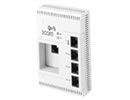'ZDNET Recommends': What exactly does it mean?
ZDNET's recommendations are based on many hours of testing, research, and comparison shopping. We gather data from the best available sources, including vendor and retailer listings as well as other relevant and independent reviews sites. And we pore over customer reviews to find out what matters to real people who already own and use the products and services we’re assessing.
When you click through from our site to a retailer and buy a product or service, we may earn affiliate commissions. This helps support our work, but does not affect what we cover or how, and it does not affect the price you pay. Neither ZDNET nor the author are compensated for these independent reviews. Indeed, we follow strict guidelines that ensure our editorial content is never influenced by advertisers.
ZDNET's editorial team writes on behalf of you, our reader. Our goal is to deliver the most accurate information and the most knowledgeable advice possible in order to help you make smarter buying decisions on tech gear and a wide array of products and services. Our editors thoroughly review and fact-check every article to ensure that our content meets the highest standards. If we have made an error or published misleading information, we will correct or clarify the article. If you see inaccuracies in our content, please report the mistake via this form.
3Com Network Jack NJ-95


3Com Network Jack NJ-95
pros and cons
- Compact physically secure can be remotely powered.
- Costs more than an equivalent desktop switch.
Running out of network ports is a common occurrence, even in sites with good structured cabling systems. The usual solution is to install a hub or switch where more ports are needed and uplink to the central comms room. 3Com's Network Jack does exactly this, but promises to be more durable and manageable than a normal desktop switch. It does this by plugging directly into a wall outlet and taking power over Ethernet.
At 7cm by 11.4cm by 2.4cm, the NJ-95 is certainly small for an Ethernet switch. LEDs on the front panel show power and uplink status, and one by each port gives its link status. There's a power connector on the bottom of the switch for an external power supply. However, the more normal -- and probably better -- way of powering the switch is via 802.11af-compliant power over Ethernet. Although this standard is still in draft at the time of writing, few of the details are expected to change and it's likely that all equipment that's compliant with the draft standard will work with the ratified version.
We were supplied with a single-port power over Ethernet module (£15.70 ex. VAT), although if you're planning to install lots of Network Jacks a 24-way power injection unit, the 3CNJPSE24, is available for £540.86 (ex. VAT). This actually works out more expensive per port (£22.54 ex. VAT) than individual single-port injection units, but is far more compact, being a 2U rack-mount unit. If you do want to use the external power supply, it costs £14.08 (ex. VAT).
Once you've chosen the method of powering the Network Jack, you can then install it. This isn't simply a case of plugging it in, since it doesn't fit directly into a wall socket. Rather it's designed to use with a backplate that replaces the faceplate of the existing socket and is screwed into place. The Network Jack then fastens into this backplate with a couple of bolts. This arrangement is for physical security, so that the unit can't easily be removed from the socket to which it's fitted. It won't stop a determined thief with the correct Allen key, but does stop the switch being moved to a different, unpowered socket.
The switch works in store-and-forward mode only, which produces more latency than cut-through switching, available on more sophisticated units. However, there's unlikely to be any traffic passing across the NJ-95 that's this sensitive to delay: even Voice over IP (VoIP) traffic shouldn't be affected by this amount of latency. Even this unmanaged version of the switch supports 802.1p packet prioritisation, so if you're using a VoIP system that supports this standard, its performance shouldn't suffer from the four-to-one contention ratio on the uplink port.
There are three other models in the Network Jack range in the US: the NJ-90, NJ-100 and NJ-200, in order of increasing functionality. The NJ-90 is a simple, unmanaged switch providing four unpowered 10/100Mbps Ethernet ports. The NJ-100 is unmanaged but provides power for a 802.11af-compliant device, while the NJ-200 is a fully-managed switch with power forwarding. Unfortunately none of these products have been adapted for use in the UK yet (outlet sizes are different in the US), so you're stuck with the NJ-95 for now.
Adding a Network Jack to a socket to expand the number of ports available will be cheaper than running more Cat5 cable, but more expensive than an unmanaged desktop switch with the same or greater number of ports -- 3Com's own OfficeConnect 5-port switch retails for around £39 (ex. VAT), for example. You could try to make the latter option as physically robust as the Network Jack by, for instance, bolting the switch to the back of a desk, which would tie the switch to a piece of furniture that could be moved. Certainly, if 3Com lowered the price of the NJ-95 to that of an unmanaged desktop switch, there'd be little reason to choose the latter; but as it is, you'll have to decide whether the NJ-95's security and robustness is worth the extra outlay.